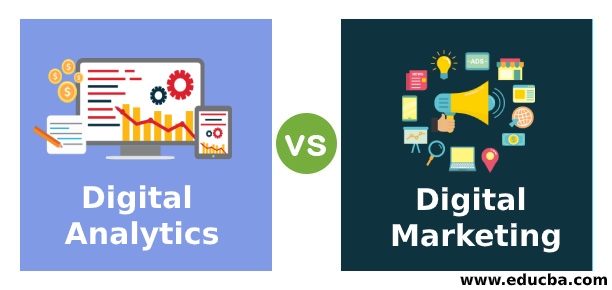Updated April 21, 2023
Introduction to Digital Analytics vs Digital Marketing
The world is continuously evolving in such a rapid manner that it is today a hectic jungle of technology and a mass of information that is vast and complicated. A decade ago, the world might have seemed simple and less complex, but that is no longer the story. That is why nations and economies will have to adapt to the changing times to survive this digital era, which is definitely here to stay.
Since its inception in 1983, the internet has completely transformed how human beings live and conduct their activities in almost all aspects of their lives. The internet today has a powerful impact on the lives of people and businesses worldwide. It has made the flow of information easier, not just on the national level but on the global level. It provides information of all kinds to not just brands but also to organizations, individuals, educational institutions, and others. Furthermore, it also helps us connect with our friends and relatives, helping us develop our relationships and keep in touch with people that matter.
Today, brands need to create a powerful presence in the online world in order to be successful. Otherwise, they will be left out and become redundant brands. Besides impressive growth, the audience reaches in the digital world is almost limitless. This is because a brand can reach millions of customers on the net, not just within their country but also around the globe. The internet is, therefore, a great medium through which brands can ensure that they remain important contributors to the lives of their clients, customers, and stakeholders.
Being present in the digital medium is, therefore, vital for brands and digital marketing companies worldwide. As people consume more and more digital content almost every second of their life, especially through mediums like smartphones, laptops, and desktops, companies need to invest in smart solutions that can help them use the immense potential of the internet and its related fields. Today, almost six billion people around the globe use smartphones to access information/services/goods of different kinds, and that is why ignoring digital communication is one of the biggest mistakes that any brand can make at the current time.
Digital marketing: The future of marketing
Digital marketing is today continuously evolving and growing almost every single day. As an evolving field, digital marketing is not just the present but the future of brands and digital marketing companies. This field is growing so rapidly that it might very soon be traditional forms of advertising like print, radio, and television. Brands and companies need to embrace this brave world of digital consumption to create campaigns that are faster, versatile, streamlined, and practical.
With so much potential in the digital medium, brands and companies who adopt this medium will see a lot of positive results in the coming years. Investing in digital communication is, therefore, one of the biggest investments that can yield positive results in the future. Some of the key forms of digital marketing include SEO content, websites, blogs, banner ads on the web, online videos, PPC advertising, email advertising, advertisements on social media that include Facebook, Twitter, LinkedIn, Instagram, and mobile marketing.
In addition, many other forms of digital content are being discovered every single day. That is why staying relevant in this industry and keeping yourself updated about all the trends takes on prime importance.
Why is digital marketing so important?
Digital marketing is undoubtedly the future of all brands and companies. Very soon, they will become extremely affordable and a cost-effective medium through which brands can reach their target audience in a powerful yet engaging manner. For example, an email or social media campaign can have far-reaching consequences that can transmit information and generate brand awareness at less cost than a television ad or print campaign on the one hand and reach a wider audience on the other hand.
Another major benefit of digital analytics marketing is that the impact and reach of each campaign can be easily tracked and monitored at every stage. This enables brands to understand the effectiveness of their campaigns without spending millions of money on customer research. In the digital medium, brands can have access to multiple tools that can allow them to track customer response rates and measure the success/failure of each campaign in real-time, and, at the same time, also help companies to plan better and more successful marketing campaigns in the future. One of the strongest reasons for incorporating digital marketing into overall marketing campaigns is that traditional marketing is quickly overtaking digital communication rapidly and quickly. Today, almost three billion people use the internet. The bottom line is that unless brands adapt to the changing marketing scenario, they will lose their brand loyalty and connect rapidly.
What is digital analytics & how does it impact digital marketing?
One of the main areas in which brands have failed to implement their digital analytics solutions. According to a recent study, there is a huge talent and hiring gap in the digital analytics arena, where many digital companies said they were in dire need of professionals who had expertise in the field of digital analytics. This means that if you are in the field of online marketing content, professionals need to gain a lot of knowledge and digital analytics skills in the field of data analytics, as this will help them take their campaigns and policies to the next stage. Therefore, data professionals need to upgrade their digital analytics skills and strategically plan their policies to improve their overall content strategy and policy.
According to Gartner, there will be more than four million big data opportunities in the next two years, and only a third will be successfully filled, which is a great challenge for the industry. All the digital analytics firms in the world are rapidly moving towards big data, which is why there are new updates in the field of mobile data, performance data, campaign data, product data, and even how data scientists are tracking data. All these changes mean that there are two major implications for this change.
The first is that brands and digital analytics companies across sectors can strengthen their digital plans by investing in good content marketers and SEO professionals. Data skills are, therefore, a very important aspect of the future of digital analytics. The second aspect of big data growth is that as campaigns grow bigger and more complex, data analytics and technological capabilities will also have to grow in a rapid manner to adjust to this demand.
Data capabilities will need to become sophisticated and capable so that larger campaigns can be implemented in a successful fashion. That is why companies and organizations need to evaluate digital marketing plans of the company in a strategic manner. In short, creating and implementing a digital analytics program needs four steps: defining the digital analytics metrics and developing a plan, collecting data, developing reporting features and capabilities, and lastly ongoing analysis and implementation.
Digital analytics is, therefore, one of the prime focus areas for all brands and companies, especially in the coming years. The term digital marketing first appeared on the scene in 2011, but it reeky gained a lot of prominence in 2013. According to the latest digital analytics trends, Google anticipates that digital analytics will gain even more traction and popularity in the coming years.
Things needed to create a successful digital analytics plan
One of the first things needed by any brand that wishes to employ a data analytics tool is the employment of people who are passionate about analytics and gaining insights from data. Many brands and companies, especially at the mid-level, are still unaware of the huge potential and opportunities that digital analytics big data can provide them, especially in terms of digital growth and expansion. Sometimes, even big organizations fail to understand the growing need to employ data analytics solutions, so they continue to invest in old techniques and methods.
Another big step needed for the implementation of data analytics is a strong and detailed budget. Many companies are guilty of investing less money in this field because they feel other departments require investment, not digital analytics. While this might be true in the short run, data analytics has huge returns, especially in the long run. While data analytics requires heavy investment in the beginning, this investment is extremely important as it helps brands get ahead of their competition and also uses the immense opportunities available on digital analytics platforms.
The next step in data analytics is the creation of key performance indicators or KPIs that will help you create strong strategies across issues, including customer engagement, reach, and conversion. This is why brands need to invest in individuals who have intense and comprehensive knowledge about the various aspects of digital analytics marketing. At the same time, it is important to create a balance between all the aspects of the metrics. Too much focus on one part of the metrics can lead to the completion of only a few goals. Brands and companies must keep the big picture in mind while creating and deciding the key metrics to add greater market value and influence.
While deciding on digital analytics, it is important that brands overview their digital analytics strategy at regular intervals so they can find out how effective their campaigns and solutions are. It is extremely important that brands evaluate their success on different social platforms because different social media platforms can have different levels of success. Analysts need to know which campaign can work on which platform and implement the said campaign on that platform which can create the maximum effect and reach.
Data visualization is one of the most important and essential parts of data analytics. Visualizing data in an effective manner is extremely important as it is only then data analysts can make sense of the data. Unless companies can make sense of data in a successful manner, there are no tangible benefits of big data. In short, data visualization is the most critical and important part of data collection, as raw data is useless to anyone. Visualizing data in the form of information, you can have valuable insights, and data analysts are the map that can help brands make sense of the vast amounts of data in the company. Data visualization allows companies to interpret data. Through this method, data analysts can identify hurdles in a process successfully and fix them before they result in a full-blown crisis that can damage the company’s growth.
For example, many e-commerce sites can have GPS installed in their vehicles to track the progress of the goods. By assigning different colors to the trucks, the company can assign colors like green for timely delivery, yellow for a possible delay, and red for delays. In this manner, the company is completely updated about the delivery mechanism, enabling them to provide better customer support and information. Also, if their vehicles run into problems like traffic and weather, they can quickly send replacements, and this would not damage the relationships between the consumer and the brand. While many companies employ digital analytics, they fail to use the data to create insights that can be used in future courses of action. It is important to uncover new digital analytics trends in the data so that marketing managers can create better and more effective plans in the future.
In Digital Analytics vs Digital Marketing, we have seen both digital analytics and digital marketing are the two pillars on which brands will continue to build their growth story in the company years. Ignoring this communication medium can prove to be fatal, which is why brands must continue to pool their resources to create strong and powerful solutions that revolve around digital analytics platforms.
Recommended Articles
Here are some further articles to learn more:





